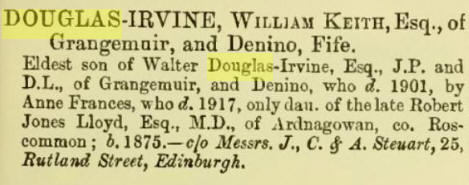|
| |
Douglas of Grangemuir
|
|

Motto: Tendir and trewe
|
The progenitor of the Douglas family of Grangemuir
is Lord William Robert Keith Douglas, whose wife Elizabeth inherited
Grangemuir House from her father.
The house and attached estate had been bought by
Walter Irvine, a Scot who owned sugar estates in Tobago and Luddington
House in Surrey.
It then passed to Irvine's daughter, Elizabeth,
and her husband, Lord William Robert Keith Douglas, the fourth son of
Sir William Douglas, 4th Baronet of Kelhead, and younger brother of both
Charles Douglas, 6th Marquess of Queensberry and John Douglas, 7th Marquess of Queensberry.
Lord William's eldest surviving son William (1824-68), the
secretary of legation at Vienna, succeeded his mother to the Irvine
estates, took that name in 1867 and was in turn succeeded by his brother
Walter Douglas Irvine (1825-1901), who disentailed the estates in 1872.
The heir, Walter
Douglas Irvine married Anne Frances Lloyd (died 1917), the daughter of
an Anglo-Irish doctor from County Roscommon in 1870. They had six
children, a number of whom were profoundly deaf. Some of these were
known by the surname "Douglas", rather than "Douglas-Irvine":
William
Keith Douglas-Irvine (1876–1957)
Capt. (Walter) Francis Douglas
(1878–1950)
Helen Florence Douglas MA (1880–1947), notable
translator, historian & fiction writer and one of the first female
graduates of St Andrews University
Rev. Henry Archibald
Douglas-Irvine BA MA (1883–1962), Parson
Charles Gordon
Douglas-Irvine (1885–1946)
Capt. Edward Percy Douglas (1886–?)
Lucy Christina Douglas-Irvine (1874?–19??), artist
Elizabeth
Douglas-Irvine (?–?)
Grangemuir House is located just north of
Pittenweem in Fife, Scotland and is now sitting within Grangemuir
Woodland Chalet Park.
The house was of French design and was
constructed as a hunting lodge for the family in the 18th century. The
building was clad in the 1970s with pebble-dashed concrete as a cheap way
of excluding damp. Members of this branch of the Douglas family usually
matriculated their arms with the mottos Jamais Arrière or Forward.
However, in 1979, the previous head of the family, Walter Francis Edward
Douglas (1917–2013), who reportedly converted to Roman Catholicism, was
granted permission by the Lord Lyon to matriculate his arms with the
motto Tendir and Trewe, as taken from the 15th century poem
The Buke of
the Howlat, by Sir Richard Holland, chaplain to Archibald Douglas, Earl
of Moray:
O Douglas, O
Douglas!
Tendir and trewe
Grangemuir House was given to
Lord William Robert Keith Douglas (born 1783 – died 1859) along with
2,700 acres of land surrounding it. On 24 November 1824, he married
Elizabeth Irvine (died 1864); the couple had three children, William
(1824–1868), Walter (1825–1901), and Charles (1837–1918). The children
founded the Douglas Cottage Hospital in St Andrews in 1866 as a memorial
to their mother, Lady William Douglas of Grangemuir - this memorial is
still reflected in the contemporary St Andrews Memorial Hospital, one of
whose wards is still called the Douglas Ward.
Grangemuir reported
annual revenues to the Treasury of £5298 in 1880, which was equivalent
to about £256,000 in 2010. The heir, Rev. Henry Archibald Douglas-Irvine, Vicar between 1932 and 1937 at Salton, Yorkshire,
married Beatrice Alice Mabel Gratix (died 1976) in 1913,
producing a son and heir, Walter Francis Edward Douglas (born 1917).
Henry's mother, Anne, was the last occupant of Grangemuir. The house and
its lands were sold in 1931, partially due to the consequences of the
Great Depression and the Irish War for Independence. The house continued
in use until the 1970s whereupon it fell into ruin and was subsequently
converted to a caravan park.
The Rev. Henry's son,
Walter Francis Edward
Douglas (born 1917 – died 2013), moved to Lincolnshire where he became
an art teacher in Stamford School. He married a Belgian. The oldest
surviving member of the family is the eldest child of Walter Francis,
Francis Gustave Douglas (born 1946), BSc, MA, PhD. Grad. Cert Ed.,
Professor Emeritus of University College Cork who has lived in Cork,
Ireland since 1980. His own heir apparent is his son Niall Edward
Douglas, BSc, MA, MBS, PGCert Ed (born 1978).
According to the
Valuation Rolls, in 1855 Lord William Douglas owned 28 properties. In
1872 when Walter Douglas assumed title, 44 properties were listed, with
further properties inherited but left untitled. In addition to
purchasing Eastern Grangemuir in 1873, he built many more properties on
his land and in the 1895 roll, some 64 properties were listed not
including properties inherited but untitled, most of which were earning
rents from tenants. Grangemuir reported annual revenues to the Treasury
of £5298 in 1880, which was equivalent to about £3,917,000 in 2016.
The family who
built Dunino church and primary school still have exclusive right of
burial in one half of the church graveyard, located just south of St
Andrews and just north of Grangemuir.
The family resumed its
connection with the area in the 1990s and 2000s when two members
attended the nearby St Andrews University. Records relating to the
Grangemuir estates, along with a small number of other family papers,
can be found in the Special Collections Archive of St Andrews University
Library. They were rescued from an Edinburgh law firm in 1994 and
subsequently donated to the University.
Elizabeth, daughter of
Lord William and his wife Elizabeth, nee Irvine, settled in the South of
France at Villa Cigala. Upon
her death on 6th December 1914, Elizabeth bequeathed her estate
(including the Cigala villa) to her nieces, Elizabeth Ethel Douglas
Irvine and Helen Florence Irvine.
|
|
Sources
Sources used for this article include:
• The Scottish Jurist:
Containing Reports of Cases Decided in the House of Lords, Courts of
Session, Teinds, and Exchequer, and the Jury and Justiciary Courts.
Michael Anderson.
• Douglas of Grangemuir Papers, 16th-20th
centuries, held by St Andrews University
• The Gazetteer for Scotland
• Grangemuir Woodland Chalet Park website
Any contributions will be
gratefully accepted
|
|


